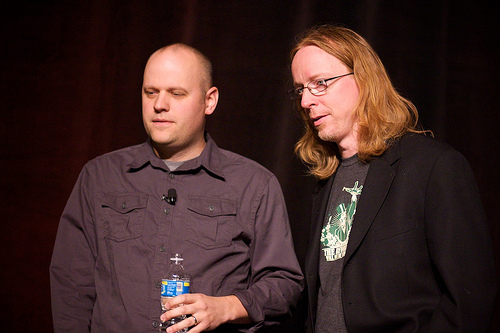
As an experiment in new new media thinking, I recently crowdsourced a new new literature version of Charles Dickens’s musty old old old lit chestnut, Great Expectations—the familiar tale of Pip, Ms Havisham, the convict Magwitch, et al.
Creative excellence and spin-worthy results required a pool of 10,000 people who had never read Great Expectations. Fortunately, I had access to 10,000 recent American college graduates, so that was no problem.
To add a dab of pseudoscience and appeal obliquely to the copyleft crowd, I remixed the new work’s leading literary themes with the top 20 Google search queries, using an algorithm I found in the mens room at Penn Station.
The result was a work of pure modern genius, coming soon to an iPad near you. (Profits from the sale will be used to support Smashing Magazine’s footer and sidebar elements.)
Gone was the fusty old title. Gone were the cobwebbed wedding cake and other dare I say emo images. It was goodbye to outdated characters like Joe the blacksmith and the beautiful Estella, farewell to the love story and the whole careful parallel between that thing and that other thing.
Gone too was the tired old indictment of the Victorian class system, and by implication of all economic and social systems that separate man from his brothers in Christ, yada yada. As more than one of my young test subjects volunteered in a follow-up survey, “Heard it.”
In place of these obsolete narrative elements, the students and the prioritized Google searches created, or dare I say curated, a tale as fresh as today’s algorithmically generated headlines.
The results are summarized in the table below.
| Old Great Expectations | New Great Expectations |
|---|---|
| On Christmas Eve, Pip, an orphan being raised by his sister, encounters the convict Magwitch on the marshes. | n/a |
| The convict compels Pip to steal food from his sister’s table, and a file from her husband the blacksmith’s shop. Pip thereby shares the convict’s guilt and sin—but his kindness warms the convict’s heart. | Guy on girl |
| Pip’s sister, Mrs. Joe, abuses him. Her husband loves Pip but is unable to protect him or offer him a future beyond blacksmithing. | Girl on girl (multiple entries) |
| Pip meets Miss Havisham, an old woman abandoned on her wedding day, who sits in her decrepit house, wearing a yellowing wedding gown, her only companion the beautiful and mysterious girl Estella. Pip falls in love with Estella, but Miss Havisham has trained the girl to break men’s hearts. | Guy on guy |
| Pip visits Miss Havisham until his apprenticeship with Joe the blacksmith begins. Pip hates being a blacksmith and worries that Estella will see him as common. | Two girls, one guy |
| Mrs Joe suffers a heart attack that leaves her mute. A kind girl named Biddy comes to take care of Mrs Joe. After Mrs Joe’s death, Biddy and Joe will marry. Meanwhile, Pip comes into an unexpected inheritance and moves to London, where he studies with a tutor and lives with his friend Herbert. | Dragons |
| Pip believes Miss Havisham is his benefactor and that she intends him to marry Estella, whom he still adores. Day by day, Estella grows more cruel. Pip never tells her of his love for her. | Wizards |
| One stormy night, Pip discovers that his benefactor is not Miss Havisham but the convict Magwitch. The news crushes Pip, but he dutifully allows Magwitch to live with him—worrying, all the while, because Magwitch is a wanted man who will be hanged if discovered. | Explosions |
| Miss Havisham repents having wasted her life and perverted Estella. She is caught in a fire. Pip heroically saves her but she later dies from her burns. Soon afterwards, Pip and Herbert try to help Magwitch escape, but Magwitch’s old enemy Compeyson—who happens to be the man who abandoned Miss Havisham at the altar—betrays Magwitch to the authorities. Magwitch and Compeyson struggle. Compeyson dies and Magwitch is taken to prison. | Gunfights |
| Pip now realizes that Magwitch is a decent man and tries to make Magwitch’s last years happy ones. He also discovers that Magwitch is Estella’s father. Magwitch dies in prison shortly before he was to be executed. Pip tells the dying Magwitch of his love for Estella. | Fistfights |
| Pip becomes ill and is nursed back to health by Joe, whom Pip recognizes as a good man in spite of his lack of education and “class.” Pip goes into business overseas with Herbert. Eventually he returns to England and visits Joe, who has married Biddy. They have a child named Pip. As the book ends, the middle-aged Pip makes one last visit to Miss Havisham’s house, where he discovers an older and wiser Estella. There is the implication that Pip and Estella may finally be together. | Anal |






